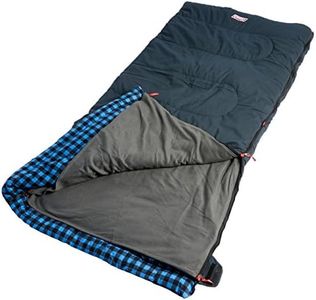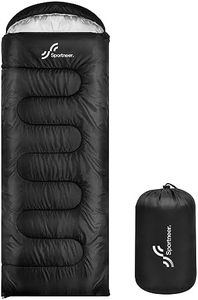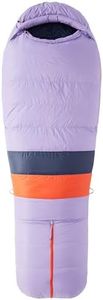We Use CookiesWe use cookies to enhance the security, performance,
functionality and for analytical and promotional activities. By continuing to browse this site you
are agreeing to our privacy policy
10 Best Hiking Sleeping Bags
From leading brands and best sellers available on the web.Buying Guide for the Best Hiking Sleeping Bags
Choosing a hiking sleeping bag can really impact your comfort, warmth, and overall hiking experience. When you pick a sleeping bag, you need to think about where, when, and how you’ll be using it. Conditions such as weather, sleeping arrangements, and how much you’ll be carrying, all play a part in what's best for you. The right sleeping bag can help you sleep well at night after a long hike, while the wrong one can leave you cold or carrying unnecessary weight. Understanding the main features helps you choose something that matches your needs and keeps you comfortable outdoors.Temperature RatingThe temperature rating tells you the lowest temperature at which the sleeping bag will keep you warm. This is important because being too cold at night can ruin your trip or even become dangerous. There are usually three segments: summer bags for above-freezing nights, three-season bags for cool spring to fall temperatures, and winter bags for freezing or below-freezing temperatures. Think about the coldest temperatures you expect to encounter on your hikes and choose a bag rated a little lower than that. If you often feel cold at night, go for an even warmer rating.
WeightThe weight of a sleeping bag matters because you carry it with you, so every gram counts, especially on longer treks. Lighter sleeping bags are usually more compact and better for long-distance backpacking, while heavier ones might keep you warmer but are bulkier. In general, ultralight bags are good for minimalists and long-distance hikers, midweight bags work for most people, and heavyweight bags are better for short trips or when you don’t have to carry your gear far. Choose a weight that matches how far you have to carry it and how much space you have in your backpack.
Insulation TypeSleeping bags are insulated with either down or synthetic fill. Down is lighter and compresses smaller, making it ideal for saving space and weight, but it loses warmth when wet. Synthetic insulation is heavier and bulkier, but it keeps you warm even if it gets wet and usually costs less. Down is best for dry conditions or if weight is your top priority, while synthetic fill is safer for wet weather or for those who want easy care. Think about the typical weather you'll encounter and your willingness to care for your bag.
ShapeThe shape of a sleeping bag affects how warm and roomy it feels. Mummy bags are form-fitting and trap heat close to your body, making them great for cold conditions but less spacious. Rectangular bags give you more room to move, making them more comfortable for warm weather or people who toss and turn. There are also semi-rectangular or 'barrel' shapes that blend both. Consider your sleeping style—if you like to move a lot, opt for a roomier shape. If warmth is your priority, go for a more fitted one.
Packed SizePacked size refers to how small the sleeping bag becomes when you compress it. This is important because it determines how much space is left in your pack for other gear. Bags with good down insulation or high-quality synthetic fill usually pack down smaller. If you have limited space or are hiking long distances, a smaller packed size can make your journey easier. Check how much space you have in your backpack and choose a bag that fits comfortably inside.
Length and WidthSleeping bags come in different lengths to fit different heights, and sometimes different widths for more or less room inside. If the bag is too short, it won’t keep you warm enough; too long, and it will be less effective at retaining heat. Some bags have wider sizes for people with larger builds or for those who want more room to move. Choose a size that matches your height (and width if you prefer more space), remembering that a closer fit usually means better warmth.
Other FeaturesAdditional features such as hoods, draft collars, zippers, and water-resistant treatments can make your sleeping bag more comfortable and functional. Hoods and draft tubes help keep warm air in, while two-way zippers allow for ventilation. Some bags come with water-resistant coatings to protect against moisture. Think about what little extras would make your nights more comfortable for the conditions where you’ll be hiking.
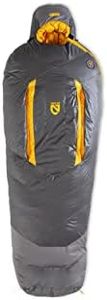

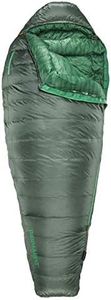


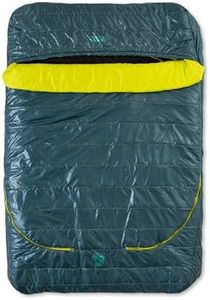

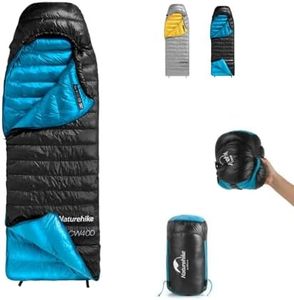
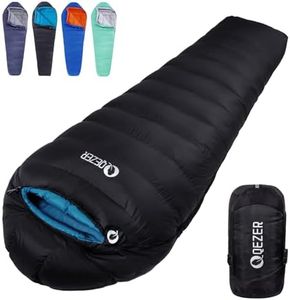
![QEZER Down Sleeping Bag for Kids Adults [ -2~7℃ / -8~0℃,1360g / 1560g ] Ultralight Winter Sleeping Bag 0 Degree for Cold Weather Camping, Hiking and Backpacking Outdoor (Blue 5℃~-3℃ Left-Zip)](https://images-proxy.bestreviews.guide/H2-shuxbN4rYMb2j5aQT5C6B0yY=/0x300/https://m.media-amazon.com/images/I/419dpQNGEHL._AC_CX679_.jpg)
